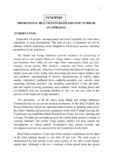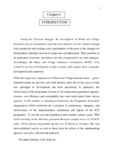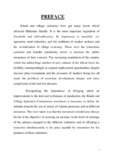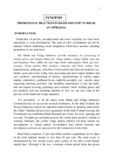Please use this identifier to cite or link to this item:
http://archive.nnl.gov.np:8080/handle/123456789/194| Title: | PROMOTIONAL PRACTICES IN KHADI INDUSTRY IN BIHAR: AN APPRAISAL |
| Authors: | Karna, Santosh Kumar |
| Keywords: | development of Khadi and Village Industries During the Freedom Struggle |
| Issue Date: | 25-Mar-2019 |
| Abstract: | During the Freedom Struggle, the development of Khadi and Village Industries was an instrument to meet the twin objective of self- reliance through local production and seeking active participation of the poor in the struggle for Independence through removal of hunger and unemployment. Their potential as an instrument of poverty alleviation was also recognized by our early planners. Accordingly, the Khadi and Village Industries Commission (KVIC) were created by an Act of Parliament to plan, promote and organize their systematic development and expansion. While the output and employment of Khadi and Village Industries have grown manifold during the last four and a half decades, their role in the context of the new paradigm of development has been questioned. In particular, the effectiveness of the programme in terms of its employment generation capacity, resource -use efficiency and sustainability has come under attack from various quarters. At the instance of planning Commission, the Programme Evaluation Organization (PEO) undertook the evaluation of performance, adequacy, and effectiveness of the implementation mechanism and impact of the KVI programme. To test the relevant hypotheses and examine various issues, PEO relied primarily on the data base generated through a sample survey of 176 KVI units, 730 beneficiary households spread over 32 blocks in 18 states. The data from published sources as well as those from the offices of the implementing agencies were also collected and analyzed. The major findings of the study are: Chapter-I INTRODUCTION 2 - The planning and implementation mechanisms are weak, as the linkages between production, sales and employment generations are not adequately considered; - The monitoring is weak and the data base used for planning and management decision does not represent the grassroots realities; - In terms of output, sales, job creation and efficiency in use of resources, the performance of the village industry sector is much better than that of the khadi sector; - The KVI programme, in spite of its poor performance, particularly in the khadi sector, holds great potential as a poverty alleviation programme∙, and - It is possible to run the scheme with reasonable level of fiscal support if, certain corrective measures, as suggested in the report, is taken. Before independence, the development of Khadi and Village Industries was entirely a non -governmental effort under the guidance of Mahatma Gandhi. After independence, the Government of India took the responsibility of bringing the development of Khadi and Village Industries within the overall framework of the Five Year Plans. Therefore, the Government of India set up Khadi and Village Industries Commission (KVIC), which is a statutory organization by an Act of parliament. This organization came up in 1956 and it plays a pivotal role in the strengthening of rural economy by promoting and developing Khadi and Village Industries. The Khadi and Village Industries programme plays a predominant role in providing employment opportunities to rural artisans more specifically the socio-economic weaker strata of the society. Since agriculture sector has been losing its ability to generate additional employment opportunities for the fast increasing workforce in rural areas, the importance of Khadi and Village Industries Commission (KVIC) has increased to find an alternative and appropriate employment for rural people. During the course of the implementation of developmental programmes, many organizations devised for their efficient management get so much ossified that their helpful impulses are completely denuded. A similar situation has arisen in the case of khadi and Village Industries Commission. It began under the inspiration of Mahatma Gandhi who wanted to organize an institution which could guide the socio-economic activities of rural areas. It was expected that this organization would promote production activities based on local resources and cater to the local markets. Such enterprises, according to Gandhiji, could eradicate rural poverty. They could transform the moribund villages into a radically dynamic centre of growth. The task was stupendous The establishment of the khadi and Village Industries Commission was expected to help in achieving this objective. The historical background of the Khadi and village Industries Commission made it a semi- political, quasi-commercial and monopolistic institution. During the course of its growth and expansion, the Commission deviated from its original objective, got involved in excessive commercial activity without adequate managerial skill, so that it finally become very unwieldy, unable to stand the burden of its own structure. As a result of this situation, the Indian villages remained backward. Rural unemployment kept mounting up. Increasing proportion of the teeming millions continued sinking below the poverty line. Several times, the working of the Commission was reviewed and radical changes suggested. But, somehow the status quo was maintained. This chapter deals with some of the basic shortcomings of the Commission which have CHAPTER- III During the course of the implementation of developmental programmes, many organizations devised for their efficient management get so much ossified that their helpful impulses are completely denuded. A similar situation has arisen in the case of khadi and Village Industries Commission. It began under the inspiration of Mahatma Gandhi who wanted to organize an institution which could guide the socio-economic activities of rural areas. It was expected that this organization would promote production activities based on local resources and cater to the local markets. Such enterprises, according to Gandhiji, could eradicate rural poverty. They could transform the moribund villages into a radically dynamic centre of growth. The task was stupendous The establishment of the khadi and Village Industries Commission was expected to help in achieving this objective. The historical background of the Khadi and village Industries Commission made it a semi- political, quasi-commercial and monopolistic institution. During the course of its growth and expansion, the Commission deviated from its original objective, got involved in excessive commercial activity without adequate managerial skill, so that it finally become very unwieldy, unable to stand the burden of its own structure. As a result of this situation, the Indian villages remained backward. Rural unemployment kept mounting up. Increasing proportion of the teeming millions continued sinking below the poverty line. Several times, the working of the Commission was reviewed and radical changes suggested. But, somehow the status quo was maintained. This chapter deals with some of the basic shortcomings of the Commission which have CHAPTER- III |
| URI: | http://103.69.125.248:8080/xmlui/handle/123456789/194 |
| Appears in Collections: | 300 Social sciences |
Files in This Item:
| File | Description | Size | Format | |
|---|---|---|---|---|
| Synopsis.pdf | 218.99 kB | Adobe PDF |  View/Open | |
| Certificate.pdf | 201.2 kB | Adobe PDF |  View/Open | |
| Main body.pdf | 1.05 MB | Adobe PDF |  View/Open | |
| Preface.pdf | 173.93 kB | Adobe PDF |  View/Open | |
| Sign.pdf | 106.29 kB | Adobe PDF |  View/Open | |
| 1_Synopsis.pdf | 218.99 kB | Adobe PDF |  View/Open |
Items in DSpace are protected by copyright, with all rights reserved, unless otherwise indicated.